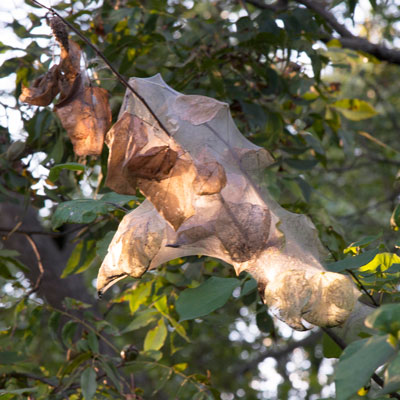A Bad Dose of Ugly
Like the tent caterpillars that show up in spring, fall webworms attack pecans, walnuts, persimmons, mulberries, and yes, even an occasional redbud. And they’re cropping up all over Texas right now.
These are the larval forms of an innocuous-looking moth. She lays her eggs, and the larvae hatch and start spinning protective webs as they feed. Initially the webs will be quite small, but within a couple of days they’ll be the size of grapefruit. That’s the time to take action, because if you leave them on their own, the outbreaks will quickly grow to engulf entire limbs.

Photo: These webworms on our redbud tree probably hadn’t noticed the lush pecan foliage (their food of choice) behind them.
Sprays aren’t the answer. First of all, the webs are water-repellent, so unless you were to include a spread-sticker (surfactant) with the insecticide, very little insecticide would penetrate into the webs to reach the caterpillars. And that says nothing about the difficulty of getting a liquid into a web that may be 15 or 20 feet off the ground. Spraying is tedious and inefficient.
Systemic insecticides aren’t much of an answer because they must be applied preemptively, and you never know if a given year is going to end up with any webworms at all. Plus you may not want to apply a systemic insecticide if food crops are involved.
Your easiest and most efficient way of eliminating webworms is to clip and remove the webs with a long-handled pole pruner while the small webs are still out at the ends of the twigs. A pole pruner will extend to reach 16 to 20 feet up, so you can eliminate many of the webs with simple pulls of the rope and clicks of the pruner. Just don’t let the webs get so large that they’re overrunning big branches. Pruning with a saw is not a solution in those cases. It would disfigure the tree.
What’s the difference between fall webworms, eastern tent caterpillars and bagworms? See below for that answer.
Do webworms do damage?
Yes, probably. But there has never been a pecan tree in Texas that was killed by fall webworms. At this point in the year, all they’re eating is really old foliage that would soon fall to the ground anyway. Their “damage” is primarily aesthetic – they just make your place look ugly.
At the Sperry house, I prune out the webworms I can reach, put them in trash bags or run smaller twigs through the mower and mulch them. I don’t anguish about the rest.
What’s the difference between fall webworms, eastern tent caterpillars and bagworms?
Having taken gardeners’ questions publicly for 46 years, I’ve heard hundreds of incorrect identifications for these three common pests. More than once I gave the wrong answer: about an insect that wasn’t even on their plants. I learned to stop long enough to be sure the person had the correct ID. This web page from the University of Illinois Extension offices says it best.
